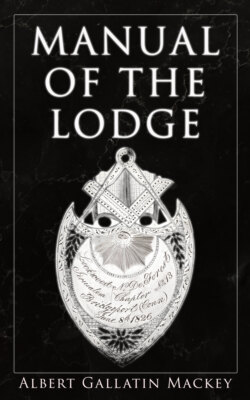Читать книгу Manual of the Lodge - Albert Gallatin Mackey - Страница 19
На сайте Литреса книга снята с продажи.
THE LAMBSKIN APRON.
ОглавлениеThe use of the apron, or some equivalent mode of investiture as a mystic symbol, was common to all the religious systems of antiquity. Among the Israelites, the girdle formed a part of the investiture of the priesthood. In the Persian mysteries of Mithras the candidate was invested with a white apron. In the Brahminical initiations of Hindostan, the Zennaar, or sacred Lord, was substituted for the apron. The Essenians clothed their novices with a white robe. Even the Japanese, in their rites of initiation, invest their candidate with a white apron.
The color of a Mason's apron should be pure white, because this color has in all ages and countries been deemed an emblem of purity and innocence. Thus, in the early ages of the Christian Church, the newly-baptized convert was invested with a white robe, to denote that he had been cleansed from his former sins, and was thenceforth to lead a life of purity. With a similar meaning, the same undefiled color has been preserved in tho apron of the Freemason.
The material of a Mason's apron must be lambskin. No other substance, such as linen, silk, or satin, can be substituted, without entirely destroying the symbolic character of the apron, because the lamb has in all ages been deemed the appropriate emblem of innocence.
The true Masonic apron should, then, be of unspotted lamb skin, from 14 to 16 inches wide, and from 12 to 14 inches deep, with a fall about 3 or 4 inches deep, square at the bottom, with sharp angular corners, and without device or ornament of any kind. The usage of the craft in this country has, within a few years past, allowed a narrow edging of blue ribbon, in allusion to that universal friendship which is the bond of the Society, and of which virtue blue is the symbol. But this, undoubtedly, is an innovation, for the ancient apron was without any edging or ornament. All extraneous ornaments and devices are in bad taste, and detract from the symbolic character of the investiture. But the silk or satin aprons, bespangled, and painted, and embroidered, which have been gradually creeping into our Lodges, have no sort of connection with Ancient Craft Masonry. They are an innovation of French origin, which should be persistently discouraged by all who admire the simplicity and beauty of our symbols. A Mason who duly and truly appreciates the symbolic meaning of his apron would no more tolerate a linen one for its economy, or an embroidered satin one for its decorations, than an artist would a gilded statue. The lambskin, and the lambskin alone, is the badge "more ancient than the Golden Fleece or Roman Eagle, and more honorable than the Star and Garter."
